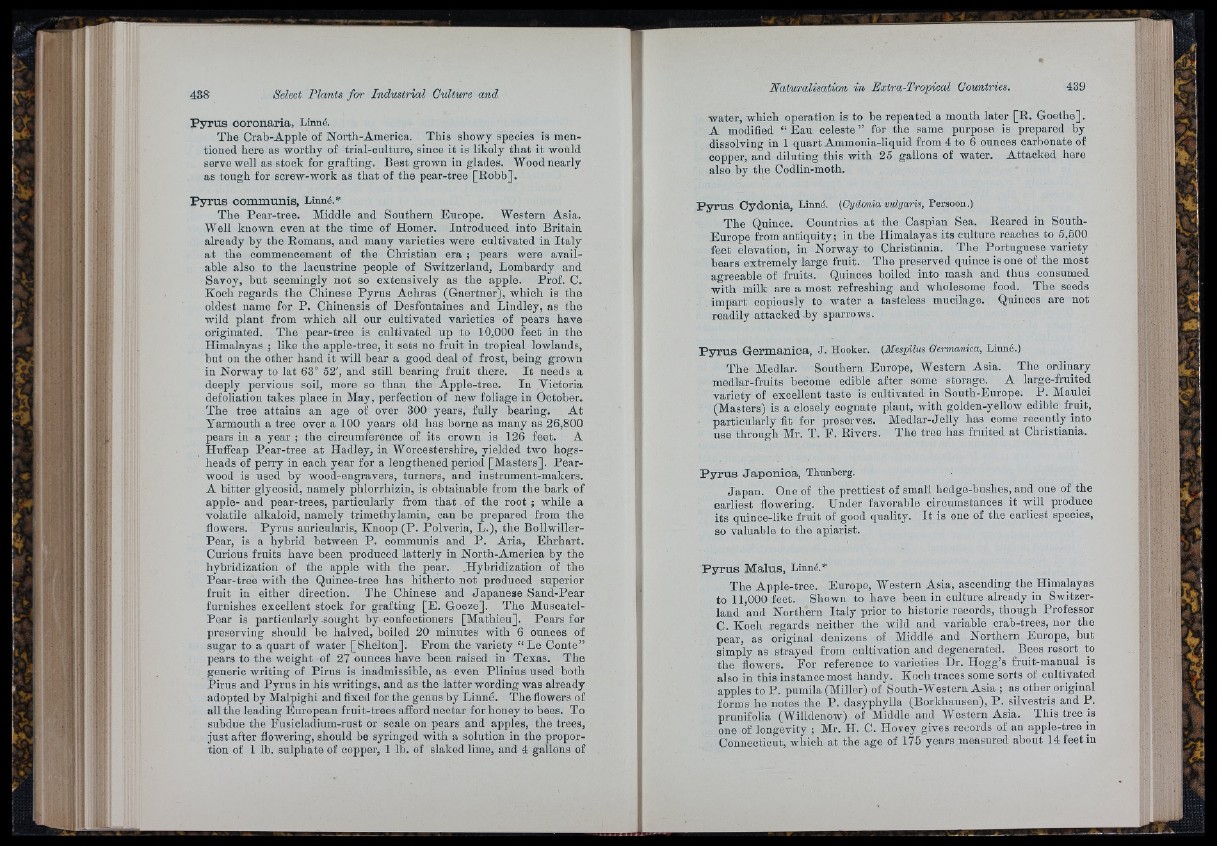
Pyrus coronaria, Linné.
The Crab-Apple of North-America. This showy species is mentioned
here as worthy of trial-culture, since it is likely th a t it would
serve well as stock for grafting. Best grown in glades. Wood nearly
as tough for screw-work as tliat of the pear-tree [Robb],
Pyrus communis, Linné.*
The Pear-tree. Middle and Southern Europe. Western Asia.
Well known even at the time of Homer. Introduced into Britain
already by the Romans, and many varieties were cultivated in Ita ly
a t the commencement of the Christian era ; pears were available
also to the lacustrine people of Switzerland, Lombardy and
Savoy, but seemingly not so extensively as the apple. Prof. C.
Koob regards the Chinese Pyrus Achras (Gaertner), which is the
oldest name for P. Chinensis of Desfontaines and Lindley, as the
wild plant from which all our cultivated varieties of pears have
originated. The pear-tree is cultivated up to 10,000 feet in the
Himalayas ; like the appie-tree, it sets uo fruit in tropical lowlands,
hut on the other hand it will bear a good deal of frost, being grown
iu Norway to lat 63“ 52', and still bearing fruit there. I t needs a
deeply pervious soil, more so than the Apple-tree. In Victoria
defoliation takes place in May, perfection of new foliage in October.
The tree attains an age of over 300 years, fully bearing. A t
Yarmouth a tree over a 100 years old has borne as many as 26,800
pears in a year ; the circumference of its crown is 126 feet. A
Huffcap Pear-tree a t Hadley, in Worcestershire, yielded two hogsheads
of perry in each year for a lengthened period [Masters]. Pear-
wood is used by wood-engravers, turners, and instrument-makers.
A bitter glycosid, namely phlorrhizin, is obtainable from the hark of
apple- and pear-trees, particularly from that of the root ; while a
vo atile alkaloid, namely trimethylamin, can be prepared from the
flowers. Pyrus auricularis, Knoop (P. Polveria, L.), the Bollwiller-
Pear, is a hybrid between P . communis and P. Aria, Ehrhart.
Curious fruits have been produced latterly in North-America by the
hybridization of the apple with the pear. .Hybridization of the
Pear-tree with the Quince-tree has hitherto not produced superior
fruit in either direction. The Chinese and Japanese Sand-Pear
furnishes excellent stock for grafting [E . Goeze], The Muscatel-
Pear is particularly-sought by confectioners [Mathieu]. Pears for
preserving should be halved, boiled 20 minutes with 6 ounces of
sugar to a quart of water [Shelton]. From the variety “ Le Conte”
pears to the weight of 27 ounces have been raised in Texas. The
generic writing of Pirns is inadmissible, as even Plinius used both
Pirus and Pyrus in his writings, and as the latter wording was already
adopted by Malpighi and fixed for the genus by Linné. The flowers of
all the leading European fruit-trees afford nectar for honey to bees. To
subdue the Fusicladium-rust or scale ou pears and apples, the trees,
just after flowering, should be syringed with a solution in the proportion
of 1 lb. sulphate of copper, 1 lb. of slaked lime, and 4 gallons of
water, which operation is to he repeated a month later [R. Goethe].
A modified “ Ean celeste” for the same purpose is prepared by
dissolving in 1 quart Ammonia-liquid from 4 to 6 ounces carbonate of
copper, and diluting this with 25 gallons of water. Attacked here
also by the Codlin-moth.
P y r u s C y d o n ia , Linné. {Gydonia vulgaris, Persoon.)
The Quince. Countries at the Caspian Sea. Reared in South-
Europe from antiquity; in the Himalayas its culture readies to 5,500
feet elevation, iu Norway to Christiania. The Portuguese variety
bears extremely large fruit. The preserved quince is one of the most
agreeable of fruits. Quinces boiled into mash and thus consumed
with milk are a most refreshing and wholesome food. The seeds
impart copiously to water a tasteless mucilage. Quinces are not
readily attacked-by sparrows.
P y r u s G e rm a n io a , J. Hooker. {Mespilus Oermanica, Linné.)
The Medlar. Southern Europe, Western Asia. The ordinary
medlar-fruits become edible after some storage. A large-fruited
variety of excellent taste is cultivated in South-Europe. P . Maulei
(Masters) is a closely cognate plant, with golden-yellow edible fruit,
particularly fit for preserves. Medlar-Jelly has come recently into
use through Mr. T. F. Rivers. The tree has fruited at Christiania.
Pyrus Japónica, Thunberg.
Jap an . One of the prettiest of small hedge-bushes, and one of the
earliest flowering. Under favorable circumstances it will produce
its quince-like fruit of good quality. I t is one of the earliest species,
so valuable to the apiarist.
Pyrus Malus, Linné.*
The Apple-tree. Europe, Western Asia, ascending the Himalayas
to 11,000 feet. Shown to have been in culture already in Switzerland
and Northern Italy prior to historic records, though Professor
C. Koch regards neither the wild and variable crab-trees, nor the
pear, as original denizens of Middle and Northern Europe, but
simply as strayed from cultivation and degenerated. Bees resort to
tbe flowers. For reference to varieties Dr. Hogg’s fruit-manual is
also in this instance most handy. Koch traces some sorts of cultivated
apples to P . pumila (Miller) of South-Western Asia ; as other original
forms he notes the P . dasyphylla (Borkhausen), P . silvestris and P.
prunifolia (Willdenow) of Middle and Western Asia. This tree is
one of longevity ; Mr. II. C. Hovey gives records of an apple-tree in
Connecticut, which at the age of 175 years measured about 14 feet in